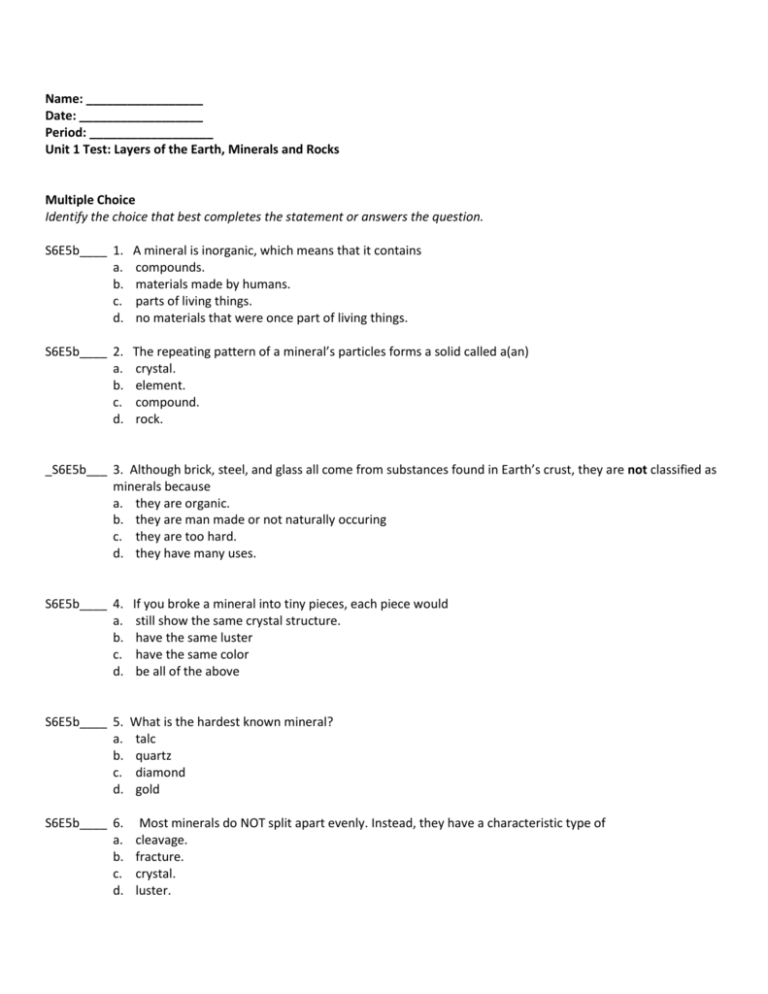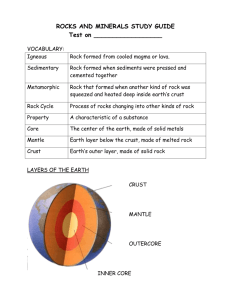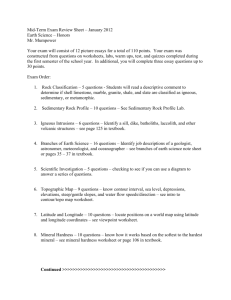Layers of the Earth
advertisement

Name: _________________ Date: __________________ Period: __________________ Unit 1 Test: Layers of the Earth, Minerals and Rocks Multiple Choice Identify the choice that best completes the statement or answers the question. S6E5b____ 1. a. b. c. d. A mineral is inorganic, which means that it contains compounds. materials made by humans. parts of living things. no materials that were once part of living things. S6E5b____ 2. a. b. c. d. The repeating pattern of a mineral’s particles forms a solid called a(an) crystal. element. compound. rock. _S6E5b___ 3. Although brick, steel, and glass all come from substances found in Earth’s crust, they are not classified as minerals because a. they are organic. b. they are man made or not naturally occuring c. they are too hard. d. they have many uses. S6E5b____ 4. a. b. c. d. If you broke a mineral into tiny pieces, each piece would still show the same crystal structure. have the same luster have the same color be all of the above S6E5b____ 5. a. b. c. d. What is the hardest known mineral? talc quartz diamond gold S6E5b____ 6. a. b. c. d. Most minerals do NOT split apart evenly. Instead, they have a characteristic type of cleavage. fracture. crystal. luster. S6E5b___7. The softest mineral on the Mohs hardness scale is a. quartz. b. talc. c. apatite. d. gypsum. S6E5d_____ 8. Each type of rock can_____________. a. Provide materials to make other rocks b. Form other rocks. c. Be changed by forces at Earth’s surface. d. All of the above. S6E5c____ 9 a. b. c. d. Igneous rock that formed from magma that cooled below the Earth’s surface is called extrusive rock. intrusive rock. clastic rock. sedimentary rock. S6E5d____ 10. The process in which dissolved minerals crystallize and glue particles of sediment together is a. compaction. b. cementation. c. deposition. d. erosion. S6E5d____ 11. a. b. c. d. Heat and pressure deep beneath Earth’s surface can change any rock into chemical rock. gemstones. metamorphic rock. sedimentary rock. S6E5d____ 12. Magma from deep inside the Earth rises toward the surface because _______ a. is more dense than the surrounding rock b.. it is less dense than the surrounding rock c. it has the same density as the surrounding rock d. none of the above S6E5b____ 13. Quartz is a mineral: granite is a_______. a. also a mineral b. a rock c. a gem d. an ore S6E5c____14. Lava that is cooled quickly forms ____________rocks a. extrusive metamorphic b. extrusive igneous c. intrusive metamorphic d. intrusive igneous S6E5d____ 15. ____ shows how one rock changes into another a. rock cycle b. melting process c. formation of crystals d. none of the above S6E5d____ 16. Formed when loose materials become pressed or cemented together or when minerals form from solutions a. igneous rocks b. metamorphic rocks c. sedimentary rocks d. minerals S6E5c ____ 17. The crystals that form in slowly cooled magma produce _________mineral grains a. tiny b. invisible c .fine-grained d. large S6E5d____ 18. ________ rocks are formed by melting and cooling a. igneous rocks b. metamorphic rocks c. sedimentary rocks d. minerals S6E5d____ 19. ________ rocks are formed by heat and pressure a. igneous rocks b. metamorphic rocks c. sedimentary rocks d. minerals S6E5d____ 20. ________ rocks are formed by compaction and cementation a. igneous rocks b. metamorphic rocks c. sedimentary rocks d. minerals S6E5c____ 21. Coal is an example of a(an) ____________________ rock, a sedimentary rock that forms where thick layers of plant and animal remains are deposited. a. clastic b. organic c. chemical d. metamorphic S6E5c___22. When sediments become pressed or cemented together ___________sedimentary rocks are formed. a. clastic b. organic c. chemical d. metamorphic S6E5c ___23. Metamorphic rocks that show layers of dark minerals alternating with light minerals are classified as ________. a. foliated b. nonfoliated c. intrusive d. extrusive S6E5c____ 24. The molten material deep inside Earth from which igneous rocks form is called a. magma b. lava c. sediment d. none of the above S6E5a____ 25. The layers of the earth in order from the most dense to the least dense are a. outer core, inner core, crust, mantle b. Inner core, outer core, mantle, crust c. crust, mantle, outer core, inner core d. none of the above S6E5a ____ 26. The layers of the earth in order from the coolest to the hottest are a. outer core, inner core, crust, mantle b. Inner core, outer core, mantle, crust c. crust, mantle, outer core, inner core d. none of the above Short Answer Use the diagram to answer each question. Word Bank: Lithosphere Asthenosphere Inner Core Convection Currents Continental Crust Oceanic Crust S6E5a S6E5a S6E5a S6E5a Core Mantle Outer Core 27. Basalt is a rock that primarily makes up the _____________________________. 28. Earth’s solid inner core is surrounded by the hot, molten metal of the ___________________. 29. The _________________ is made up of the Lithosphere and the Asthenosphere. 30. ______________________ are the movement of heat that assist in the plates moving around in the Lithosphere. S6E5a 31. Soft pliable rocks can be found in the _______________________. S6E5a 32. The majority of the ______________________________ is made up of the intrusive igneous rock Granite. S6E5a 33. The movement found in the Earth’s _________________ causes the Earth’s Magnetic Field. S6E5a 34. The density of the Earth’s _______________________________ is caused by the increase of heat and pressure the closer that one gets to the center of the Earth. S6E5a 35. The crust is similar in composition as the __________________________, which is found in the Earth’s Mantle. Use the diagram to answer each question. Mohs Hardness Scale S6E5b_____36. Mineral Hardness Talc 1 Gypsum 2 Calcite 3 Fluorite 4 Apatite 5 Feldspar 6 Quartz 7 Topaz 8 Corundum 9 Diamond 10 What would happen if you rubbed a piece of fluorite against a piece of feldspar? a. The fluorite would scratch the feldspar b. The feldspar would scratch the flourite S6E5b ____37. What would you expect to happen if you rubbed a mineral of hardness 7.5 against a piece of quartz? a. The quartz would scratch the other mineral b. The other mineral would scratch the quartz S6E5b ____38. If an unknown mineral has a hardness between 5 and 9, what could you do to the mineral to find out more about its hardness? a. See if it scratches glass b. See if your fingernail will scratch it S6E5b ____39. Which minerals in the table will scratch quartz? a. Feldspar, Apatite, Flourite b. Topaz, Corundum, Diamond S6E5b ____40. List the following minerals in order of decreasing hardness: apatite, calcite, corundum, feldspar, and talc. a. Corundum, Feldspar, Apatite, Calcite, Talc b. Talc, Calcite, Apatite, Feldspar, Corundum







